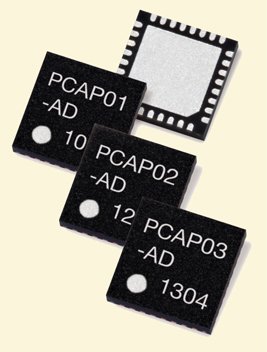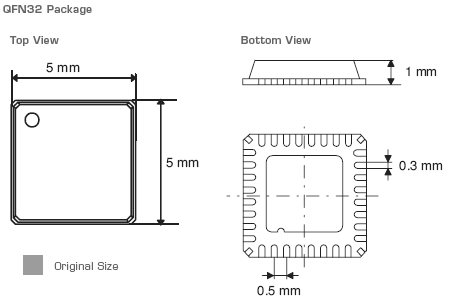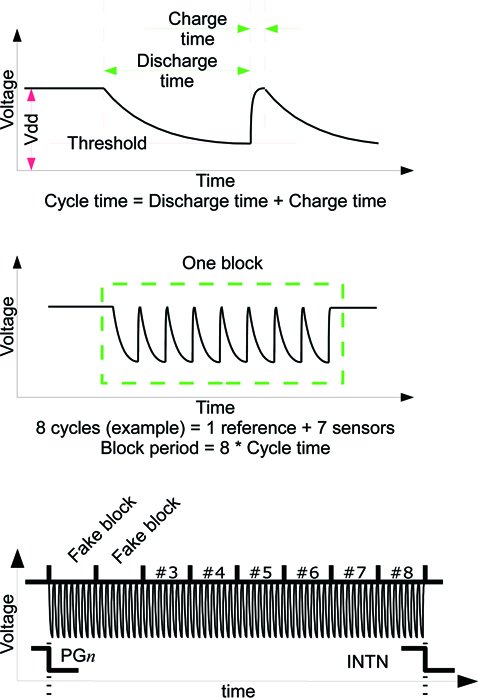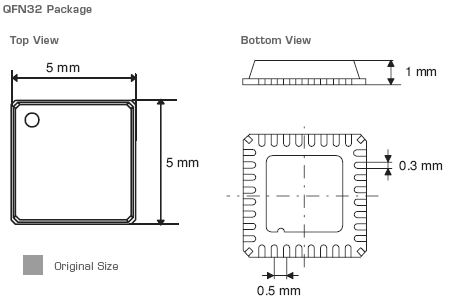PICOCAP Capacitive Sensor Chip
The capacitive sensor chips provide the most flexible, high-performing, and accurate product solution with the patented PICOCAP—direct capacitance-to-digital conversion—measuring principle. We supply capacitance measurement chips with input capacitance ranging between 0fF to hundreds of nF, providing a broad and practically limitless capacitance value measurements for your products. Their broad input capacitance range allows you to use the capacitive sensor chips in multiple versatile applications.
With our TDC technology, we can measure with picosecond resolution, allowing us to have very short discharge times in the microsecond range. The input capacitance can range from a Picofarad to hundreds of Nanofarads, implying that the size of the capacitor is virtually limitless.
The multi-channel CDC offers a high level of versatility in terms of accuracy, speed, and operating current. Users can adjust averaging and sample rate to achieve high resolution (20 Bit), low power (3 µA), and high speed (50 kHz). A strong integrated CPU allows for on-chip linearization, temperature sensing, and adjustment.
Ensure precise direct capacitance-to-digital conversion measurements with capacitive sensor chips supplied from PMT.
PicoCap: Capacitance Measurement
Advantages
- 2 channels with typ. 50 ps rms resolution
- 65 ps Bin size
- Measurement range 3.5 ns to 1.8 µs
- 15 ns pulse-pair resolution with 4-fold multihit capability
- 4 events can be measured arbitrarily against each other
- Windowing for precise stop enable
Applications
- Humidity sensors
- Pressure sensors
- MEMS
- Acceleration sensors
- Inclination sensors
- Freefall sensors
- Position sensors
- Touch sensors
- Angle sensors
- Level sensors
- Microphones
Application Diagram

Package Outline
Additional Information
PICOCAP: PCAP SERIES
PCap01 has been the first chip of the PICOCAP ® product line and was introduced to the market in early 2010. Now, in early 2013 mass production samples of the successor PCap02 have been released (full mass production planned in Q2/2013) with a particular focus on humidity applications. Also in early 2013 engineering samples of PCap03 for highest performance applications will be available

Picocap Products
| Product | Channels | Resolution | Max ssample rate [Hz] | Capacitance range [F] | I [μA] | Memory | CPU | Interface | Package |
| PCAP04 | 6 | 20 Bit 8aF | 500k | 1p to 100n | 3@3 Hz/13 Bit | 1k NVRAM 3k ROM | 32 Bit | SPI/I2C PDM/PWM | QFN24 |
| PCAP02 | 8 | 19 Bit 15 aF | 500k | 1p to 100n | 3@3 Hz/13 Bit | 4k SRAM 4k OTP | 48 Bit | SPI/I2C PDM/PWM | QFN32 |
| PCAP01 | 8 | 20 Bit 6aF | 50k | 1p to 100n | 3@3 Hz/13 Bit | 4k SRAM 4k OTP | 48 Bit | SPI/I2C | QFN32 |
PicoCap Measurement Principle
he PICOCAP measuring principle shows a new approach to capacitance measurement. For this purpose the sense capacitor and a reference capacitor are connected to a resistor, forming a low-pass filter. Sense and reference capacitor should be in the same range to minimize gain drift. Practically there is no limit for the capacitor value. Sensors from nearly 0 fF up to tens of nF can be measured. The PICOCAP devices also support differential sensors with inside linearization.
The capacitors are charged to the supply voltage and then discharged through the resistor. The discharge time down to an arbitrary trigger level is measured with ultra-high precision using a TDC (Time-to-Digital Converter).
This measuring process is repeated in time-multiplex with both Capacitors, using the same resistor and the same comparator. Calculating the ratio of the results will turn out the absolute values and temperature dependencies of the resistor and the comparator.
The Compensated Mode offers the solution for highest resolution applications with low offset and extremely low gain drift. The capacitors are connected floating, not referenced to ground. They are switched alternately to the resistor by an integrated analog switch. Additional patented circuits and algorithms compensate for parasitic capacities. Parasitic capacities would have a negative effect on the gain drift over temperature. The compensation results in a very low gain drift over temperature down to 0.5 ppm / K. It is much better than the intrinsic gain drift of most sensors.

General Circuit

Cycle Time

Ordering Numbers
Type |
Part Number |
Package |
RoHS compl. |
Shipping Package |
| PCap02: | ||||
| PCap02A | Dice | Yes | ||
| PCap02AE | QFN32 | Yes | ||
| PCap02-EVA-KIT | System | Yes | Box | |
| PCap01: | ||||
| PCap01A | MNR 1613 | Dice | Yes | |
| PCap01AD | MNR 1793 | QFN32 | Yes | |
| PCap01AK | MNR 1795 | QFN24 | Yes | |
| PCap01-EVA-KIT | MNR 1912-01 | System | Yes | Box |
| PCap01-HUM-EVA | MNR 1796 | System | Yes | Box |
| PCap01-HUM-DEMO | MNR 1792 | System | Yes | Box |
Ordering Numbers
Type |
Part Number |
Package |
RoHS compl. |
Shipping Package |
| PCap02: | ||||
| PCap02A | Dice | Yes | ||
| PCap02AE | QFN32 | Yes | ||
| PCap02-EVA-KIT | System | Yes | Box | |
| PCap01: | ||||
| PCap01A | MNR 1613 | Dice | Yes | |
| PCap01AD | MNR 1793 | QFN32 | Yes | |
| PCap01AK | MNR 1795 | QFN24 | Yes | |
| PCap01-EVA-KIT | MNR 1912-01 | System | Yes | Box |
| PCap01-HUM-EVA | MNR 1796 | System | Yes | Box |
| PCap01-HUM-DEMO | MNR 1792 | System | Yes | Box |

